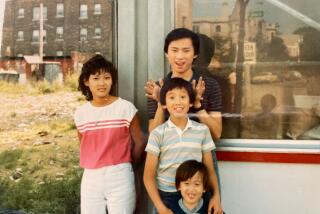The big picture
- Share via
A couple of years ago, as he approached his 70th birthday, Herbert Kohl decided he needed to do something for himself. The longtime educator and author was struggling to come to terms with aging, as well as with his grief at the collapse after four years of the University of San Francisco’s Center for Teaching Excellence and Social Justice, a program he founded that had “ended bitterly,” cut by the university after the funds Kohl had raised ran out.
For Kohl, the key to dealing with these traumas was to reopen himself to learning and develop a new skill. “During hard times,” he notes, “I often feel the compelling need for new growth.” An amateur painter, he enrolled in a beginner’s class in Chinese painting at a small storefront art academy on San Francisco’s Clement Street, and the experience confounded him from the start. No sooner had he arrived for the first session than he discovered that all of his fellow students were between the ages of 5 and 7, Chinese American kids whose very presence forced him to reconsider his expectations -- both of the class and of himself. “I was a child in an old guy’s body,” Kohl recalls, “and when I sat down that day, my body disappeared and the child in me emerged once again. . . . I was on the ground again, a sixty-nine-year-old six-year-old. What fun!”
“Painting Chinese” is the story of that reemergence -- a slim, discursive memoir that bears some of the matter-of-factness of Chinese painting itself. What’s most interesting about the book is how the making of art, which Kohl first thought of as a diversion, becomes more like meditation, a way to reflect on the ebb and flow of life. Kohl is refreshingly candid about the press of mortality, considering without self-pity what to do with the remaining time he has. “I could still teach, write, and paint during the time left to me -- fifteen, maybe twenty years,” he notes in one characteristically direct passage, adding, with a touch of wistfulness, that it “seemed such a short time.”
With its roots in Taoist thinking, Chinese painting is all about this sort of contradiction -- the balance between the infinite and finite; the way dying renders our accumulated wisdom for naught. You can’t hold on, Kohl tells us, but must embrace the incompleteness, see it as an essential part of life. That’s an important message, and he gives it beautiful expression, framing Chinese painting both as a metaphor and as a powerful, enigmatic process in its own right.
Kohl’s journey is marked with fleeting triumphs and false steps -- for instance, his inability to disconnect his analytical mind and express himself, like a child, in the moment. The book emerges as a guide for living, staking out not answers so much as a strategy to carry on. Partly, this has to do with Kohl’s acceptance of ambiguity; “The void in traditional Chinese painting,” he quotes Nobel laureate in literature Gao Xingjian, “functions as a kind of psychological space.” But even more, he recognizes that answers are out of his hands. “There is no need to resolve everything,” Kohl writes at the end of this exquisite volume. “Death will take care of that.”
--
David L. Ulin is book editor of The Times.
More to Read
Sign up for our Book Club newsletter
Get the latest news, events and more from the Los Angeles Times Book Club, and help us get L.A. reading and talking.
You may occasionally receive promotional content from the Los Angeles Times.











